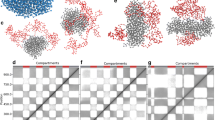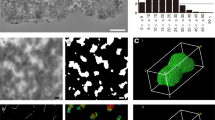Abstract
Recent statistical analysis of the folding of G0/G1 chromosomes using fluorescence in situ hybridization (FISH) allowed development of a random walk/giant loop model of chromosome structure. According to this model there are two levels of organization of G0/G1 chromosome fibres. On the first level, the fibres are arranged in giant loops several Mbp in size, and within each loop the fibres are randomly folded. On the second level, the loop attachment sites form a chromosome backbone that also shows random folding. Newly replicated segments of mammalian chromosomes may be directly visualized at high resolution in S-phase nuclei using immunofluorescent methods and appear as worm-like fibres. In our earlier study, we analysed conformation of the fibres in human cells blocked for 16 h at the G1/S boundary with 5- fluorodeoxyuridine (FdU) and then released into S-phase by the addition of a DNA prec ursor. However, long treatment of cells with FdU induces very short replicons and may promote apoptosis. In this study we analysed conformation of the fibres in normally proliferating human cells that had not been blocked with FdU for a long time. It has been found that replicated chromosome fibres visualized just after 2 h of incubation of the cells with a non-radioactively labelled DNA precursor behave as flexible polymer chains without major constraints, and that their local conformation in the range of several microns of their contour length may be considered as random. Confocal analysis of human X chromosomes visualized in HeLa cells using FISH with a specific painting probe shows that in S-phase the chromosomes occupy distinct nuclear territories and their apparent size does not differ from that in non-S-phase cells. This observation indicates that the second level of chromosome organization also exists in S-phase chromosomes. It appears, theref ore, that the random walk/giant loop model developed earlier for G0/G1 chromosomes is also valid for S-phase chromosomes.
Similar content being viewed by others
References
Cairns J (1966) Autoradiography of HeLa cell DNA. J Mol Biol 15: 372–373.
Eils R, Dietzel S, Bertin E et al. (1996) Three-dimensional reconstruction of painted human interphase chromosomes: active and inactive X chromosome territories have similar volumes but differ in shape and surface structure. J Cell Biol 135: 1427–1440.
Hozak P, Hassan AB, Jackson DA, Cook PR (1993) Visualization of replication factories attached to a nucleoskeleton. Cell 73: 361–373.
Hand R (1978) Eucaryotic DNA: organization of the genome for replication. Cell 15: 317–325.
Lawrence JB, Singer RH, McNeil JA (1990) Interphase and metaphase resolution of different distances within the human dystrophin gene. Science 249: 928–932.
Liapunova NA (1994) Organization of replication units and DNA replication in mammalian cells as studied by DNA fiber radioautography. Int Rev Cytol 154: 261–308.
Lichter P, Cremer T, Borden J, Manuelidis L, Ward DC (1988) Delineation of individual human chromosomes in metaphase and interphase cells by in situ suppression hybridization using recombinant DNA libraries. Hum Genet 80: 224–234.
Liu B, Sachs RK (1997) A two-backbone polymer model for interphase chromosome geometry. Bull Math Biol 59: 325–337.
Lloyd E (ed.) (1984) Handbook of Applied Mathematics. John Wyley and Sons.
Manuelidis L (1990) A view of interphase chromosomes. Science 250: 1533–1540.
Martins LM, Earnshaw WC (1997) Apoptosis: alive and kicking in 1997. Trends Cell Biol 7: 111–114.
Morton NE (1991) Parameters of the human genome. Proc Natl Acad Sci USA 88: 7474–7476.
Nakamura H, Morita T, Sato C (1986) Structural organization of replicon domains in eukaryotic cell nucleus. Exp Cell Res 165: 291–297.
Nakayasu H, Berezney R (1989) Mapping replicational sites in the eukaryotic cell nucleus. J Cell Biol 108: 1–11.
Newport J, Yan H (1996) Organization of DNA into foci during replication. Cur Opin Cell Biol 8: 365–368.
O'Keefe RT, Henderson SC, Spector DL (1992) Dynamic organization of DNA replication in mammalian cell nuclei: spatially and temporally defined replication of chromosomespeci fic alpha-satellite DNA sequences. J Cell Biol 116: 1095–1110.
Painter RB, Young BR (1975) X-ray induced inhibition of DNA synthesis in Chinese hamster ovary, human HeLa, and mouse L cells. Radiation Res 64: 648–656.
Painter RB, Young BR (1976) Formation of nascent DNA molecules during inhibition of replicon initiation in mammalian cells. Biochim Biophys Acta 418: 146–153.
Pienta KJ, Partin AW, Coffey DS (1989) Cancer as a disease of DNA organization and dynamic cell structure. Cancer Res 49: 2525–2532.
Pinkel D, Landegent J, Collins C et al. (1988) Fluorescence in situ hybridization with human chromosome-specific libraries: detection of trisomy 21 and translocations of chromosome 4. Proc Natl Acad Sci USA 85: 9138–9142.
Raap AK, van de Corput MP, Vervenne RA, van Gijlswijk RP, Tanke HJ, Wiegant J (1995) Ultra-sensitive FISH using peroxidase-mediated deposition of biotin-or fluorochrome tyramides. Hum Mol Genet 4: 529–534.
Sachs RK, van den Engh G, Trask B, Yokota H, Hearst JE (1995) A random walk/giant loop model for interphase chromosomes. Proc Natl Acad Sci USA 92: 2710–2714.
Santisteban MS (1995) Structure of chromatin. 2: levels of organization of DNA in the nucleus. Highly organized structures. Pathol Biol 43: 420–447.
Svetlova M, Solovjeva L, Stein G, Chamberland C, Vig B, Tomilin N (1994) The structure of human S-phase chromosome fibres. Chromosome Res 2: 47–52.
Taylor JH, Hozier JC (1976) Evidence for a four micron replication units in CHO cells. Chromosoma 57: 341–350.
Tomilin N, Rozanov Y, Zenin V, Bozhkov V, Vig B (1993) A new and rapid method for visualising DNA replication in spread DNA by immunofluorescence detection of incorporated 5-iododeoxyuridine. Biochem Biophys Res Commun 190: 257–262.
Tomilin N, Solovjeva L, Krutilina R, Chamberland C, Hancock R, Vig B (1995) Visualization of elementary DNA replication units in human nuclei corresponding in size to DNA loop domains. Chromosome Res 3: 32–40.
Tomilin N, Solovjeva L, Svetlova M et al. (1996) Organization of DNA replication units in human chromosomes. In: Abbondandolo A, Vig BK, Roi R, eds. Proceedings on Chromosome Segregation and Aneuploidy. Genoa: IST Press, pp 151–163.
Trask BJ, Pinkel D, van den Engh GJ (1989) The proximity of DNA sequences in interphase cell nuclei is correlated to genomic distance and permits ordering of cosmids spanning 250 kilobase pairs. Genomics 5: 710–717.
van den Engh GJ, Sachs R, Trask BJ (1992) Estimating genomic distance from DNA sequence location in cell nuclei by a random walk model. Science 257: 1410–1412.
Yokota H, van den Engh G, Hearst JE, Sachs RK, Trask BJ (1995) Evidence for the organization of chromatin in megabase pair sized loops arranged along a random walk path in the human G0/G1 interphase nucleus. J Cell Biol 130: 1239–1249.
Author information
Authors and Affiliations
Rights and permissions
About this article
Cite this article
Solovjeva, L., Svetlova, M., Stein, G. et al. Conformation of Replicated Segments of Chromosome Fibres in Human S-phase Nucleus. Chromosome Res 6, 595–602 (1998). https://doi.org/10.1023/A:1009293108736
Issue Date:
DOI: https://doi.org/10.1023/A:1009293108736




